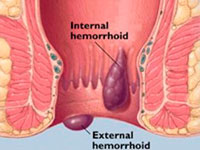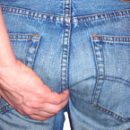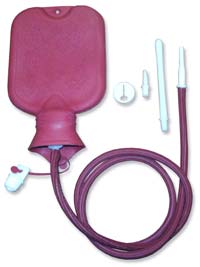During the course of the disease, its features should be distinguished, namely, external hemorrhoids or internal, chronic or acute. Let's talk about such a form of illness as an external hemorrhoids whose treatment implies an integrated approach.
Content
 This disease in which people of working age are in the risk group, and the factors of the development of external hemorrhoids are:
This disease in which people of working age are in the risk group, and the factors of the development of external hemorrhoids are:
-
constipation, which lead to an increase in pressure in the rectum and provoke blood flow to already expanded nodes, as a result of which they increase and fall out;
- sedentary lifestyle and hypodynamia;
- pregnancy and childbirth;
- Alcohol abuse.
The development of the disease is characterized by a gradiment, when the pain is first detected only during defecation, then when there is a fitting or exercise, lifting weights and even when coughing and sneezing. In the initial stages, hemorrhoidal nodes can still be aroused with muscle efforts, and then when they are already constantly outside the anal channel, are markers of external chronic hemorrhoids with periodic, participating painful exacerbations. This condition is accompanied by bleeding, strong itching, pain, and help in this case can only be expected from such surgical intervention as the removal of external nodes.
Treatment of external hemorrhoids
There are several approaches in the therapy of this ailment, depending on the development stage, the degree of severity of clinical manifestations, as well as the presence of other concomitant diseases. All these moments determine the paths and methods of successful therapy not only external, but also internal hemorrhoids. Treatment involves a conservative drug method using folk remedies. Among them, first of all, the fight against pathological constipation, the use and regular use of antigenuclear preparations in the form of candles, ointments, gels and creams.
 Recommended sediment baths with decoractions, infusions, juices, as well as therapeutic massage and phytotherapy at home, where many people prefer to treat the disease, experiencing a false shame and a lot of inconvenience in connection with a proctologist.
Recommended sediment baths with decoractions, infusions, juices, as well as therapeutic massage and phytotherapy at home, where many people prefer to treat the disease, experiencing a false shame and a lot of inconvenience in connection with a proctologist.
However, it should not be forgotten that the conservative methods are more often temporary, and therefore preference in the therapy of external hemorrhoids should be given a minimally invasive surgery.
Minimally invasive surgery
Modern operations are characterized by minor soreness and low trauma, widely used in the early stages of the disease:
- sclerotherapy;
- infrared coagulation;
- Ligation of hemorrhoidal nodes with special rubber rings;
- Gearing hemorrhoidal nodes under the control of ultrasound.
Surgical techniques are actively used in specialized hospitals, where successfully treat hemorrhoids today has become possible due to modern knowledge using high-tech equipment. The abbreviated period of stay in the hospital and excellent results are increasingly attracting patients to where hemorrhoids can be treated with painlessly, reliable and fast.
Anal sex and hemorrhoids: benefit or harm?
 Many procratist specialists and sexopathologists directly indicate the connection between anal sex and the occurrence of hemorrhoids. On the one hand, non-traditional sexual experience leads to the activation of the muscles of the rear pass, contributes to their training and warns the appearance «uncomfortable disease». On the other hand, during anal sex, in the case of internal hemorrhoidal nodes, similar sexual contact exacerbates the pattern of the disease, provokes serious and dangerous complications, not yet visualized, and in no way indicate specific localization where to treat. Hemorrhoid in this case and at this stage has not yet been assigned a stage and a degree, but the manifestation of the disease in the form of discomfort of itching and burning is already tangible.
Many procratist specialists and sexopathologists directly indicate the connection between anal sex and the occurrence of hemorrhoids. On the one hand, non-traditional sexual experience leads to the activation of the muscles of the rear pass, contributes to their training and warns the appearance «uncomfortable disease». On the other hand, during anal sex, in the case of internal hemorrhoidal nodes, similar sexual contact exacerbates the pattern of the disease, provokes serious and dangerous complications, not yet visualized, and in no way indicate specific localization where to treat. Hemorrhoid in this case and at this stage has not yet been assigned a stage and a degree, but the manifestation of the disease in the form of discomfort of itching and burning is already tangible.
The negative consequences of anal sex and hemorrhoids, which is localized in this zone, can turn into damage and inflammation of the turbulence of the rectum, the development of acute inflammatory processes and, finally, the possibility of spreading urogenital infections. Doctors recommend the manifestation of moderation, and the pause between the contacts should be at least one week, because in the acute course of the disease, such proximity is contraindicated, and with the slightest suspicions for complications, the immediate appeal to the doctor is recommended.








